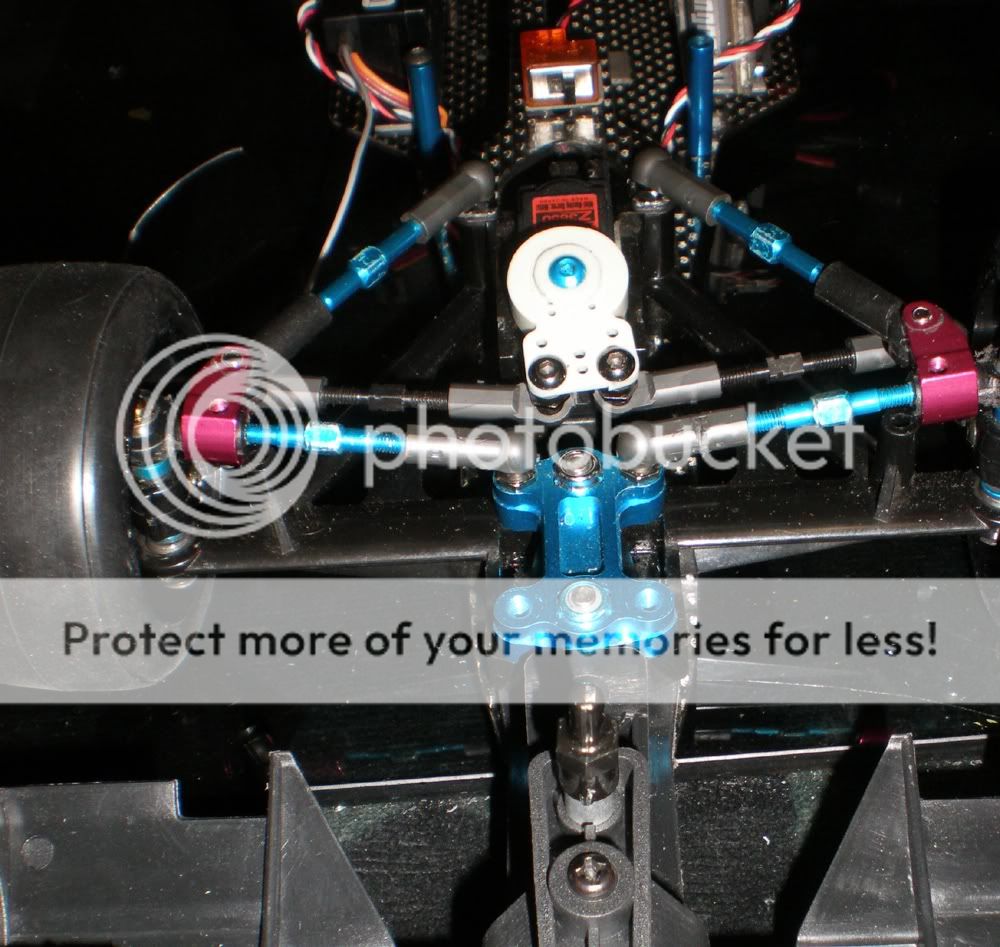A few years ago a friend who was a long time 1/12 guy, and national level A main racer, among other things, really clued me into how steering geometry works on pan type cars. Working with the concepts he explained to me really opened up possibilities I did not know existed. Sometimes, there were things I wanted to change on the car that I didn't know how to get without big compromises, or even how to change at all. The steering on your car can actually affect almost all areas of set up, things that would be counter intuitive in some cases.
The big one is the bump steer settings. Generally, in a typical servo set up with the output shaft pointing up, you will use maybe 5mm of shims on the bottom of the servo saver. That will generally get the tie rods somewhat level. What is this really doing?
A more typical setup has some spacers underneath the servo saver to get the arms sort of level. A level tie rod will have a minimal amount of bump steer and make the car feel pretty much the same in all phases of the corner. Usually, this is the best approach to take at first. It's fairly easy to add or remove spacers in small increments like 0.5 or 1mm to tune things in. Big changes are good to familiarize yourself to the extremes, but remember to look at the tie rod length to maintain toe as close as possible!
Adding spacers to the servo saver making the tie rods run down towards the inside of the car will make the car steer more in the beginning of the turn. Additionally, spacers on the knuckle tend to make the car more reactive at first turn in as well. This does increase the angle of the rods as the spacers on the servo saver does, but I think that the difference in height from the axle is a little different from just adjusting the rod's angle in general.
The other factor in the steering is Ackermann. The difference in the steering radius of the two front tires generally affects overall steering and aggressiveness. Generally, moving the servo saver ball studs forward, whether by servo position or length of the servo saver/steering arm, will increase aggressiveness and steering. This will also kill some mid corner roll speed, especially on carpet. On asphalt, this can actually be a benefit, since it's almost like drag brake.
Making a straighter tie rod will promote roll speed in high bite conditions (note most 1/12 cars are fairly straight), and be less aggressive. Rubber tires do seem to like a bit of angle to make the tires work.
The other part of the equation is the actual servo saver. The width of the space between the ball studs makes a difference. Narrower spacing tends to be more aggressive. Wider less so.
The other part of the equation is the track width on both ends of the car.
At the front, I like a wider car in general. It promotes more on power steering, and helps the car be more stable under the brakes or on corner entry. Narrowing the front will make the car a bit more nervous, and help turn in. There is usually less overall steering, however. Having on power steering is key in my estimation since the car's corner speed is important to lap time since they do not have the acceleration of a 4wd car. I try to get the car as wide as rules allow, and the track conditions will permit.
As far as the rear I generally try to make the car narrow as conditions will permit, to gain rotation mid corner. It will also feel like there is more side bite as well. In high bite, like carpet, this can work very well. On asphalt, it pays to try to run as wide as you can while maintaining rotation. A wider rear will be more stable out of the corner (launch), and will keep the tires from overheating during the run. The overheating is less of a concern on carpet. In the past, the 190mm width limit led some option part manufacturers to make widening kits for cars. Enjoying some initial popularity, a lot of drivers wound up removing the kits and going back to stock width, looking for steering. As it turns out, just removing the rear end parts and leaving the front 190mm would have been even faster. Widening the rear of the car will lock it down and kill corner speed on a tight track, especially high traction carpet. I like to use 0.5 mm spacers on the axle to widen 1mm at a time. It's a change that you can feel but it's not too drastic.
To me, these are the basic settings after tires that will establish the overall feel and balance of the car, along with ride height. Most of the rest like springs, oil, camber are finer, but still important, adjustments. It's just that the things I have described about are more "macro" and will change the character of the car immediately. I hope this will help get more guys into the ballpark a little faster. Don't take my word for it, try it out!






this just blew my mind thru my plastic underpants. I will read this until it make sense because, well apparently I've been doing this all wrong for 6 years.
ReplyDelete